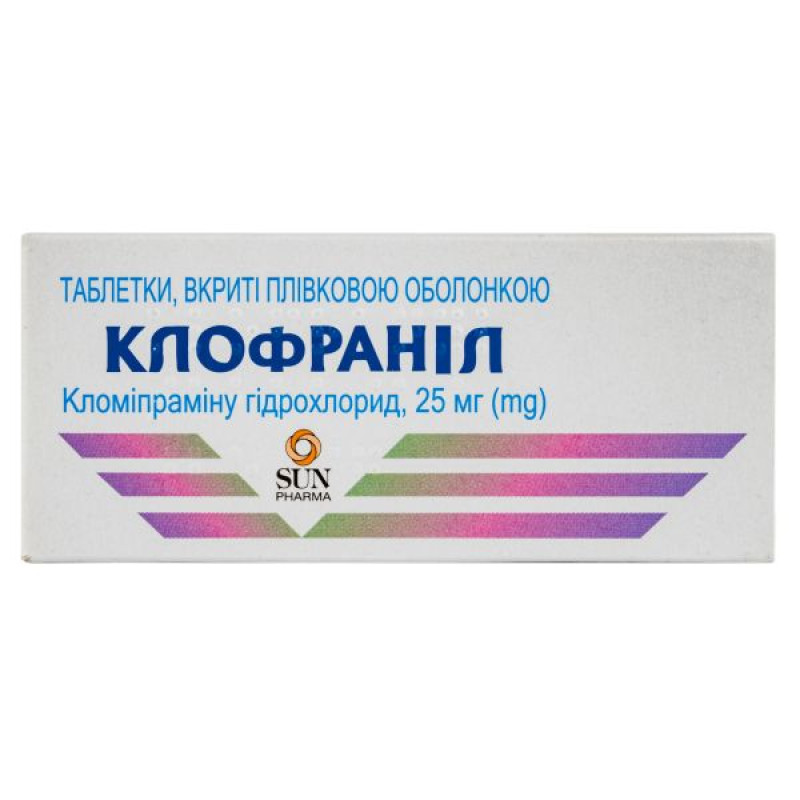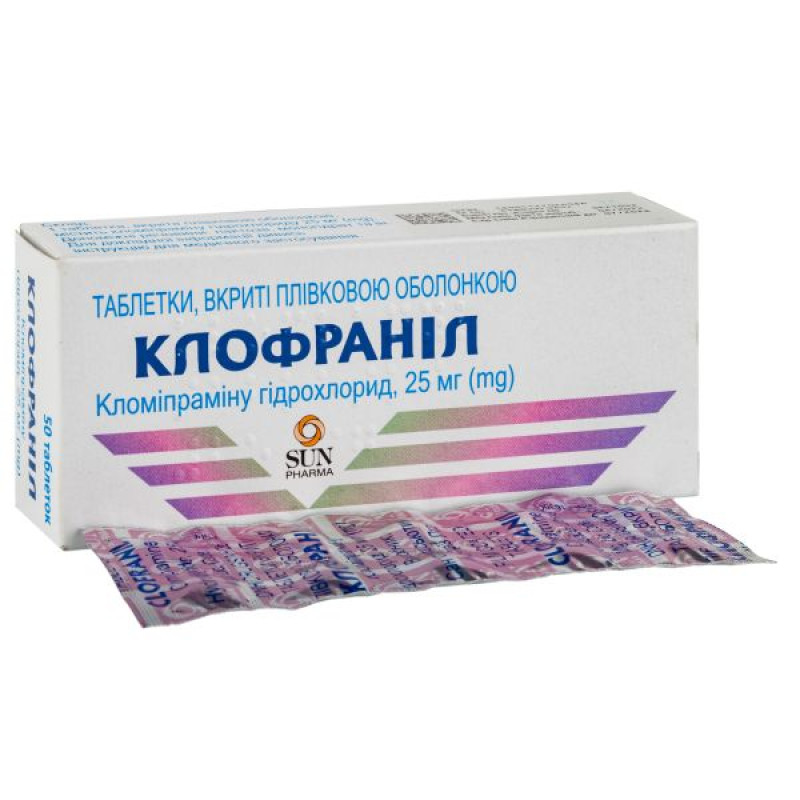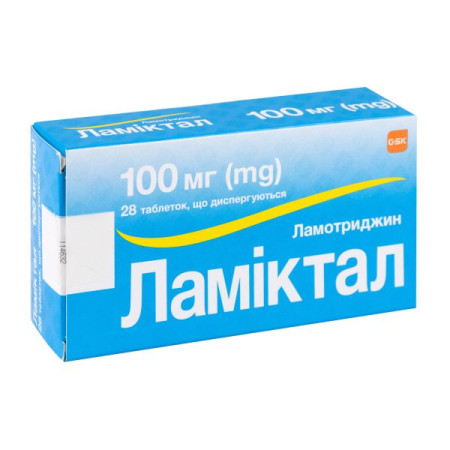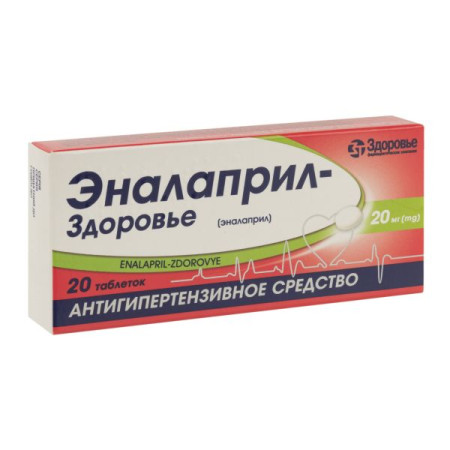Clofranil film-coated tablets 25 mg No. 50
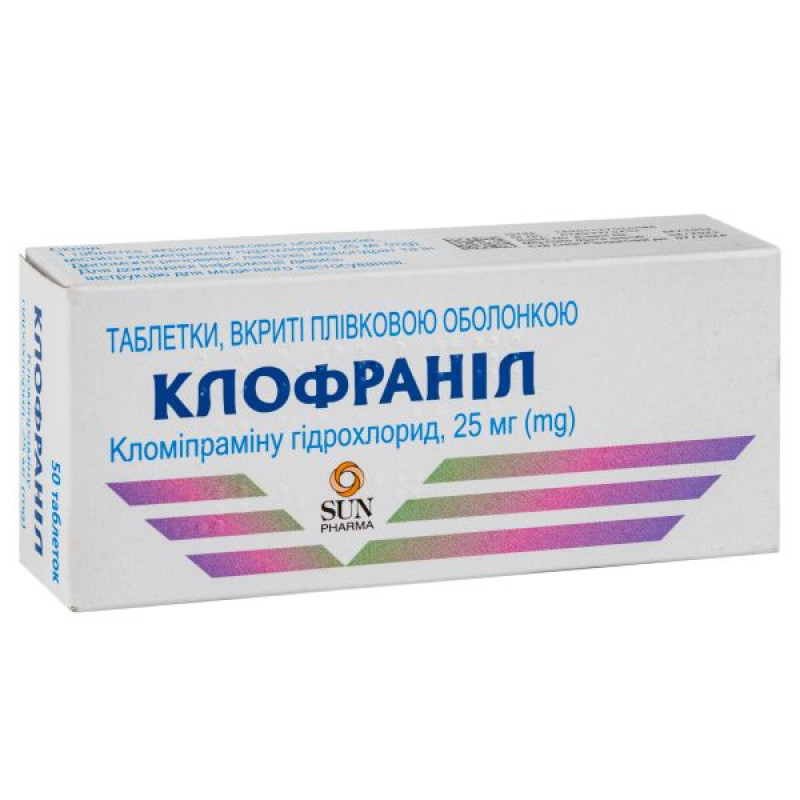
Instructions for use Clofranil film-coated tablets 25 mg No. 50
Composition
active ingredient: clomipramine;
1 tablet contains clomipramine hydrochloride 25 mg;
Excipients: lactose monohydrate; corn starch; microcrystalline cellulose; talc; magnesium stearate; colloidal anhydrous silica; sodium starch glycolate; hypromellose; titanium dioxide (E 117); polyethylene glycol 6000; diamond blue (E 133).
Dosage form
Film-coated tablets.
Main physicochemical properties: round, film-coated tablets, blue in color with a break line on one side and smooth on the other.
Pharmacotherapeutic group
Antidepressants. Nonselective inhibitors of neuronal monoamine reuptake.
ATX code N06A A04.
Pharmacological properties
Pharmacodynamics.
The therapeutic effect of clomipramine is due to its ability to inhibit the neuronal reuptake of norepinephrine (NE) and serotonin (5-HT), with the most important being the inhibition of serotonin reuptake.
Clomipramine, in addition, has a wide range of other pharmacological actions: alpha1-adrenolytic, anticholinergic, antihistamine, and antiserotonergic (blockade of 5-HT receptors).
Clomipramine affects the depressive syndrome as a whole, including mainly its typical manifestations such as psychomotor retardation, depressed mood and anxiety. The clinical effect is usually observed after 2-3 weeks of treatment.
Clomipramine also has a specific effect in obsessive-compulsive disorders that is distinct from its antidepressant effect.
The action of clomipramine in chronic pain syndromes, caused or not caused by somatic diseases, is associated with the facilitation of nerve impulse transmission mediated by serotonin and noradrenaline.
Pharmacokinetics.
Absorption: Clomipramine is completely absorbed from the gastrointestinal tract. The systemic bioavailability of the unchanged drug is approximately 50%, which is due to extensive first-pass metabolism in the liver, which leads to the formation of the active metabolite, N-desmethylclomipramine.
After taking a constant dose of the drug, the steady-state plasma concentrations of clomipramine vary considerably in individual patients. With daily use of the drug at a dose of 75 mg/day, the steady-state plasma concentration of the drug is established in the range of 20-175 ng/ml.
The steady-state concentrations of the active metabolite N-desmethylclomipramine are in a similar range. However, when taking clomipramine 75 mg per day, these values are 40-85% higher than the concentration of clomipramine.
Distribution. Clomipramine is 97.6% bound to plasma proteins. The apparent volume of distribution is approximately 12-17 L/kg body weight. Concentrations in cerebrospinal fluid are approximately 2% of those in plasma. Clomipramine is excreted in breast milk, where it is found in concentrations similar to those in plasma.
Metabolism. The primary metabolic pathway of clomipramine is demethylation to form the active metabolite, N-desmethylclomipramine. N-desmethylclomipramine can be formed by several P450 enzymes, primarily CYP3A4, CYP2C19, and CYP1A2. Clomipramine and
N-desmethylclomipramine is hydroxylated to form 8-hydroxyclomipramine or 8-hydroxy-N-desmethylclomipramine. The activity of the 8-hydroxy metabolites has not been determined in vivo. Clomipramine is also hydroxylated at the 2-position and N-desmethylclomipramine can be further demethylated to form didesmethylclomipramine. The 2- and 8-hydroxy metabolites are excreted as glucuronides in the urine. The elimination of the active components clomipramine and N-desmethylclomipramine to form 2- and 8-hydroxyclomipramine is catalyzed by CYP2D6.
Elimination: After oral administration, the plasma half-life of clomipramine is on average 21 hours (range 12 to 36 hours), and that of desmethylclomipramine is on average 36 hours.
Approximately 2/3 of a single dose of clomipramine is excreted in the urine as water-soluble conjugates and approximately 1/3 of the dose is excreted in the feces. Approximately 2% of the administered dose of clomipramine and approximately 0.5% of desmethylclomipramine are excreted in the urine as unchanged drug.
Pharmacokinetics in certain groups of patients. In elderly patients, regardless of the dose of clomipramine taken, due to a decrease in the intensity of clomipramine metabolism, its plasma concentrations are higher than in younger patients. The effect of impaired liver and kidney function on the pharmacokinetics of clomipramine has not yet been studied.
Indication
Adults.
Depressive states of various etiologies, occurring with different symptoms:
endogenous, reactive, neurotic, organic, masked, involutional forms of depression;
depression in patients with schizophrenia and psychopathy;
depressive syndromes occurring in the elderly; depressive states caused by chronic pain syndrome or chronic somatic diseases;
depressive mood disorders of a reactive, neurotic or psychopathic nature.
Phobias and panic disorders (attacks).
Obsessive-compulsive disorders.
Chronic pain syndrome (specific pain syndrome in cancer, neuropathic and idiopathic pain syndromes).
There is still insufficient evidence of the safety and efficacy of Clofranil in the treatment of children with depressive states of various etiologies, phobias, panic disorders, cataplexy accompanying narcolepsy, and chronic pain syndrome. Therefore, Clofranil should not be used for these indications in children and adolescents under 18 years of age.
Contraindication
Hypersensitivity to clomipramine or to any other ingredients of the drug, cross-hypersensitivity to tricyclic antidepressants of the dibenzazepine group.
Antiarrhythmic drugs, such as quinidine and propafenone, which are potent CYP2D6 inhibitors, should not be administered in combination with tricyclic antidepressants.
Concomitant use of MAO inhibitors, as well as a period of less than 14 days before and after their use. Concomitant use of selective MAO-A reverse inhibitors (such as moclobemide) or non-selective MAO-A reverse inhibitors (such as linezolid) is also contraindicated.
Recently suffered a myocardial infarction.
Congenital long QT syndrome.
Acute intoxication with CNS depressants (such as hypnotics, analgesics, or psychotropic drugs) or alcohol.
Acute urinary retention.
Acute delirium;
Untreated angle-closure glaucoma.
Prostatic hypertrophy with final urinary retention.
Pyloric stenosis.
Paralytic intestinal obstruction.
Interaction with other medicinal products and other types of interactions
Pharmacodynamic interaction
MAO inhibitors. Clofranil should not be administered for at least 2 weeks after discontinuation of MAO inhibitors (there is a risk of developing such severe symptoms and conditions as hypertensive crisis, hyperpyrexia, myoclonus, agitation, generalized seizures, delirium and coma). The same rule should be followed if an MAO inhibitor is administered after previous treatment with Clofranil. In any of these cases, the initial doses of Clofranil or MAO inhibitors should be small, and they should be increased gradually, under constant monitoring of the effects of the drug.
The risk suggests that Clofranil should not be used until 24 hours after discontinuation of a reversible MAO-A inhibitor such as moclobemide. However, if such a drug is prescribed after discontinuation of Clofranil, the interval should be at least 2 weeks.
Because the antibiotic linezolid is a nonselective, reversible MAO inhibitor, it should not be administered to patients receiving clomipramine.
Selective serotonin reuptake inhibitors. The use of Clofranil in combination with these agents may lead to an increased effect on the serotonin system.
Serotonergic agents: Serotonin syndrome may occur when clomipramine is used with serotonergic agents such as selective serotonin reuptake inhibitors (SSRIs) and serotonin-norepinephrine reuptake inhibitors (SNaRIs), tricyclic antidepressants, or lithium salts. It is recommended that clomipramine be withheld for 2 to 3 weeks before and after treatment with fluoxetine.
Antiadrenergic drugs that affect neuronal transmission of excitation. Clofranil can reduce or completely eliminate the antihypertensive effect of guanethidine, betanidine, reserpine, clonidine and alpha-methyldopa. Therefore, in cases where treatment of arterial hypertension is necessary while taking Clofranil, another type of drug should be used (for example, vasodilators or beta-blockers).
Sympathomimetics: Clofranil may enhance the effects on the cardiovascular system of adrenaline, noradrenaline, isoprenaline, ephedrine and phenylephrine (including when these substances are part of local anesthetics).
CNS depressants: Tricyclic antidepressants may enhance the effects of alcohol and other CNS depressants (e.g., opiates, barbiturates, benzodiazepines, or general anesthetics).
Anticholinergics: Tricyclic antidepressants may potentiate the anticholinergic effects of a number of drugs (e.g. phenothiazines, antiparkinsonians, antihistamines, atropine, biperiden) on the eye, CNS, bowel and bladder. There is a risk of hyperthermia.
Diuretics. Concomitant use of Clofranil with diuretics may lead to hypokalemia, which in turn increases the risk of QTc prolongation and torsades de pointes. Hypokalemia should be treated before prescribing Clofranil.
Pharmacokinetic interaction
Concomitant use of CYP2D6 inhibitors may result in up to an approximately three-fold increase in the concentrations of both active substances in patients with the extensive metaboliser phenotype of debrisoquine/sparteine, converting their phenotype to a poor metaboliser phenotype. Concomitant use of CYP1A2, CYP2C19 and CYP3A4 inhibitors results in increased concentrations of clomipramine and decreased concentrations of N-desmethylclomipramine, so such use does not necessarily affect the overall pharmacology.
MAO inhibitors that are also potent CYP2D6 inhibitors in vivo, such as moclobemide, are contraindicated for co-administration with clomipramine.
Antiarrhythmic drugs (such as quinidine and propafenone), which are potent inhibitors of CYP2D6, should not be used in combination with tricyclic antidepressants.
Selective serotonin reuptake inhibitors that are CYP2D6 inhibitors, such as fluoxetine, paroxetine, sertraline, and fluvoxamine, which inhibits other CYPs including CYP1F2 and CYP2C19, also increase plasma concentrations of clomipramine with associated adverse effects. Steady-state serum levels of clomipramine are increased approximately 4-fold when coadministered with fluvoxamine (N-desmethylclomipramine levels are decreased approximately 2-fold).
Concomitant treatment with neuroleptics (e.g. phenothiazines) may lead to an increase in plasma levels of tricyclic antidepressants, a lowering of the seizure threshold and seizures. Combination with thioridazine may lead to severe cardiac arrhythmias.
Concomitant use with terbinafine, a strong CYP2D6 inhibitor, may increase exposure and accumulation of clomipramine and its N-demethylated metabolites. As a result, the dose of Clofranil should be adjusted when the drugs are used together.
Concomitant use with histamine2 (H2) receptor antagonists, cimetidine (an inhibitor of several P450 enzymes, including CYP2D6 and CYP3A4) may increase the plasma concentration of tricyclic antidepressants, so their dose should be reduced.
Interaction in the case of continuous administration of oral contraceptives (15 or 30 mg of ethinylestradiol daily) and Clofranil (25 mg daily) has not been established. There are no data on estrogens as inhibitors of CYP2D6, the main enzyme involved in the clearance of clomipramine, and therefore no interaction is expected. Although in some cases, when using high doses of estrogen (50 mg daily) and the tricyclic antidepressant imipramine, an increase in adverse reactions and therapeutic effect was noted, there is no evidence of such a dependence on clomipramine and the need to reduce estrogen doses when they are used simultaneously. Monitoring the effectiveness of tricyclic antidepressants is recommended.
Methylphenidate may increase the concentration of tricyclic antidepressants by inhibiting their metabolism, therefore it is necessary to adjust the dose of Clofranil.
Concomitant use of valproate with clomipramine may inhibit CYP2C and/or UGT enzyme metabolism and thus increase plasma levels of clomipramine and desmethylclomipramine.
Concomitant use of Clofranil and grapefruit, grapefruit and cranberry juice may alter the concentration of clomipramine in the blood plasma.
Some tricyclic antidepressants may enhance the anticoagulant effect of coumarins (e.g. warfarin), possibly by inhibiting their metabolism (CYP2C9). Monitoring of prothrombin in plasma is recommended. Concomitant use of Clofranil with drugs that induce cytochrome P450, especially CYP3A4, CYP2C19 and/or CYP1A2, may enhance the metabolism and reduce the efficacy of Clofranil.
CYP3A4 and CYP2C19 inducers, such as rifampicin or anticonvulsants (e.g. barbiturates, carbamazepine, phenobarbital and phenytoin), may lead to a decrease in the plasma concentration of clomipramine.
Known inducers of CYP1A2 (e.g. nicotine/other components of cigarette smoke) reduce concentrations of tricyclic antidepressants. The steady-state concentration of clomipramine in smokers is 2-fold lower than in non-smokers (there is no change in the concentration of N-desmethylclomipramine). Clomipramine inhibits CYP2D6 activity (sparteine oxidation) both in vivo and in vitro and, as a result, may increase the concentrations of concomitantly administered drugs metabolized primarily by CYP2D6 in patients with an extensive metabolizer phenotype.
Concomitant use with ion exchange resins such as cholestyramine or colestipol may result in decreased plasma concentrations of clomipramine. If concomitant use is necessary, it is recommended that clomipramine be administered at least 2 hours before or 4-6 hours after the administration of the resins.
Concomitant use of Clofranil and St. John's wort (Hipericum perforatum) may reduce the concentration of clomipramine in the blood plasma.
Application features
Suicide risk.
Depression is associated with an increased risk of suicidal thoughts, self-harm and suicide. Exacerbations of suicidal thoughts and suicidal behaviour may occur in patients treated with antidepressants.
Published data from studies of selective serotonin reuptake inhibitors (SSRIs) and similar medicines suggest an increased risk of suicidal behaviour when treated for depression in children, adolescents and young adults (aged under
25 years). A similar effect cannot be excluded for other antidepressants (including Clofranil), for which relevant data are lacking.
Therefore, patients receiving antidepressants should be closely monitored for signs of worsening depression, including suicidal behavior, and/or akathisia (restlessness, psychomotor agitation), particularly at the beginning of therapy and when the dose is changed. In addition, patients should be closely monitored after discontinuation of treatment, as similar symptoms may occur upon discontinuation of treatment or in the initial phase of relapse.
In addition to depressive states, psychiatric illnesses may also be associated with an increased risk of suicidal behavior, therefore, the same precautions should be observed as with antidepressant treatment.
Relatives and caregivers of the patient should be informed that they should be vigilant for the development of other symptoms of psychiatric illness (see "Adverse reactions") and suicidality, and immediately report them to the physician providing medical care to the patient.
Antidepressant treatment is not a complete substitute for hospitalization, which is necessary if the patient poses a threat to himself. The doctor should prescribe the lowest available dose of the drug, especially at the beginning of therapy, to avoid the risk of such a situation.
With regard to the risk of fatal overdose, fewer fatalities have been reported with Clofranil than with other tricyclic antidepressants. To reduce the risk of overdose, the lowest possible dose of Clofranil should be used to achieve the optimal therapeutic effect for the patient.
Psychiatric effects.
Many patients with panic attacks experience increased anxiety at the beginning of treatment with Clofranil. This paradoxical increase in anxiety is most pronounced in the first days of therapy and usually subsides within 2 weeks.
Activation of psychosis has occasionally been reported in patients with schizophrenia receiving tricyclic antidepressants. The activating effect of tricyclic antidepressants may lead to increased anxiety, restlessness, and agitation in patients with agitation or concomitant schizophrenic symptoms.
It is known that patients with cyclic affective disorders who take tricyclic antidepressants may develop manic or hypomanic states during the depressive phase. In such cases, it may be necessary to reduce the dose of Clofranil or to discontinue it and prescribe an antipsychotic. After the relief of these conditions, if indicated, treatment with Clofranil in low doses can be resumed.
In patients prone to mental disorders and elderly patients, tricyclic antidepressants can provoke the development of pharmacogenic psychosis (delirium), mainly at night. After discontinuation of the drug, these disorders disappear within a few days.
Convulsions.
It is known that tricyclic antidepressants lower the seizure threshold, so Clofranil should be prescribed with extreme caution to patients with epilepsy, as well as in the presence of other factors that cause the occurrence of convulsive syndrome, for example, with brain damage of any etiology, simultaneous use of neuroleptics, during the period of abstinence from alcohol or withdrawal of drugs that have anticonvulsant properties (for example, benzodiazepines). It is believed that the occurrence of seizures while taking Clofranil depends on the dose of the drug. In this regard, the recommended daily dose of Clofranil should not be exceeded.
Clofranil, like other tricyclic antidepressants, is prescribed in combination with electroconvulsive therapy only under close medical supervision.
Anticholinergic effects.
Since the drug has anticholinergic properties, it should be prescribed with extreme caution to patients with a history of increased intraocular pressure, angle-closure glaucoma, or urinary retention (e.g., due to prostate disease).
Due to the anticholinergic action inherent in tricyclic antidepressants, a decrease in tear secretion and a relative increase in the amount of mucus in the tear fluid may occur, which may lead to damage to the corneal epithelium in patients who use contact lenses.
Serotonin syndrome.
Due to the risk of serotonergic toxicity, recommended doses should be followed and the dose should be increased with caution if another serotonergic drug is prescribed concomitantly. Serotonin syndrome, with features such as hyperpyrexia, myoclonus, agitation, seizures, delirium and coma, may occur when clomipramine is used concomitantly with serotonergic drugs such as selective serotonin reuptake inhibitors, serotonin-norepinephrine reuptake inhibitors, tricyclic antidepressants or lithium, triptans, L-tryptophan, tramadol, fentanyl or sibutramine. It is recommended that clomipramine not be used for 2-3 weeks before and after treatment with fluoxetine.
Clofranil should be administered with extreme caution to patients with cardiovascular diseases, especially cardiovascular insufficiency, intracardiac conduction disorders (e.g. atrioventricular block I-III degree) or arrhythmias. In such patients, as well as in elderly patients, it is necessary to regularly monitor the cardiovascular system and ECG.
There is a possible risk of prolongation of the QT interval and atypical ventricular tachycardia when higher therapeutic doses of clomipramine are prescribed, as well as in the case of co-administration with selective serotonin reuptake inhibitors or serotonin-norepinephrine reuptake inhibitors. Therefore, the simultaneous administration of drugs that can cause accumulation of clomipramine should be avoided. It is also necessary to avoid the simultaneous administration of drugs that can prolong the QT interval. The basis of these phenomena is hypokalemia. Therefore, before prescribing Clofranil or Clofranil in combination with serotonin inhibitors, serotonin-noradrenergic inhibitors or diuretics, it is necessary to determine the level of potassium in the blood serum and, if it decreases, it should be corrected. The combined use of Clofranil with selective serotonin reuptake inhibitors, serotonin-noradrenaline reuptake inhibitors and diuretics requires caution.
Before starting therapy with Clofranil, it is recommended to measure blood pressure, since a sharp decrease in blood pressure is possible in patients with orthostatic hypotension or with vascular lability.
Special patient groups.
Caution should be exercised when treating patients with severe liver disease and patients with adrenal medulla tumors (e.g., pheochromocytoma, neuroblastoma) with tricyclic antidepressants, as hypertensive crisis may develop in this case.
Caution should be exercised when treating patients with hyperthyroidism and patients receiving thyroid hormone preparations, as the anticholinergic effects of tricyclic antidepressants may exacerbate adverse cardiac effects.
If necessary, in patients with kidney and liver diseases, constant monitoring of both the level of liver enzymes and kidney function, as well as the concentration of the active substance and its metabolites in the blood plasma, is recommended.
Caution is required when treating patients with chronic constipation with Clofranil. Tricyclic antidepressants can cause paralytic ileus, especially in elderly patients or in patients who are bedridden.
Caries has been reported with long-term treatment with tricyclic antidepressants. Therefore, regular dental examinations are recommended during long-term treatment with Clofranil.
There are no data on further safety for children and adolescents regarding growth, puberty, and cognitive and behavioral development.
Hypersensitivity reactions.
There have been isolated cases of anaphylactic shock. Intravenous administration of Clofranil requires caution.
Changes in blood test results.
Although changes in leukocyte counts during treatment with Clofranil have been reported only in isolated cases, periodic monitoring of peripheral blood counts and monitoring for symptoms such as fever and sore throat are recommended, especially during the first months of therapy or during prolonged use of the drug. If the neutrophil count falls below normal, the drug should be discontinued.
Anesthesia.
Before performing general or local anesthesia, the anesthesiologist should be warned that the patient is taking Clofranil.
Other effects.
Hyperthermia as a symptom of neuroleptic malignant syndrome has been observed in several patients receiving concomitant neuroleptic therapy with Clofranil.
Drug withdrawal.
Abrupt withdrawal of Clofranil should be avoided as this may lead to adverse reactions. If it is necessary to discontinue therapy, the dose should be reduced as rapidly as possible, but always bear in mind that abrupt withdrawal of therapy may lead to adverse reactions.
Lactose content.
Patients with rare hereditary forms of galactose intolerance, severe lactase deficiency, or glucose-galactose malabsorption should not use the drug.
Use during pregnancy or breastfeeding
There is clear evidence of risk to the human fetus, but this risk may be outweighed by the therapeutic benefit to the pregnant woman. Since there are isolated reports of a possible association between the use of tricyclic antidepressants and fetal malformations, the use of Clofranil during pregnancy should be avoided unless the expected benefit to the pregnant woman clearly outweighs the potential risk to the fetus.
To avoid the development of this syndrome, Clofranil should be discontinued gradually approximately 7 weeks before the expected delivery according to clinical indications.
Since the active substance of the drug penetrates into breast milk, breastfeeding should either be discontinued or Clofranil should be gradually discontinued.
Ability to influence reaction speed when driving vehicles or other mechanisms
Patients taking Clofranil should be warned that they may experience blurred vision, dizziness and other CNS disorders (see section "Adverse Reactions") and that in such cases they should refrain from driving, operating other mechanisms, and engaging in other activities that require increased attention. Patients should also be warned that these effects may be enhanced by taking other medications and alcohol.
Method of administration and doses
Adults.
Hypokalemia must be treated before prescribing Clofranil.
The dose of the drug should be selected individually, taking into account the patient's condition. The treatment tactic is to achieve the optimal effect against the background of the use of the smallest doses of the drug, as well as to carefully increase them, especially for elderly patients (aged 65 and over) and adolescents, who are more sensitive to Clofranil than patients of other age groups.
After maintenance therapy, the optimal dose should be maintained. In patients with a history of depressive relapse, maintenance therapy may be indicated for a longer period of time, depending on the individual risk of relapse. The duration and need for further therapy should be reviewed periodically.
To prevent possible QT prolongation and serotonergic toxicity, the recommended dose of Clofranil should not be exceeded. Any increase in the dose of Clofranil requires caution in the case of concomitant use of other serotonergic drugs that prolong the QT interval.
Abrupt discontinuation of therapy without any medical reason should be avoided, as this may lead to adverse reactions. If Clofranil must be discontinued after long-term therapy, the dose should be reduced gradually and the patient should be closely monitored.
Depression, obsessive-compulsive syndromes and phobias. Treatment should be initiated with 1 film-coated tablet containing 25 mg of clomipramine 2-3 times a day. Then, during the 1st week of treatment, the dose of the drug should be gradually increased, for example, by 25 mg every few days (depending on tolerability), until a daily dose of 4-6 tablets of 25 mg is reached. In severe cases, the daily dose can be increased to a maximum of 250 mg.
After a clear improvement is achieved, select a maintenance dose of the drug, which is 2-4 tablets of 25 mg.
Panic disorders, agoraphobia. Treatment should be started with 10 mg of clomipramine per day. Then, depending on the tolerability of Clofranil, its dose is increased until the desired effect is achieved. The daily dose of Clofranil required in these cases varies significantly among patients and is in the range of 25-100 mg. If necessary, it can be increased to 150 mg. It is not recommended to stop treatment for 6 months, the maintenance dose should be slowly reduced during this period.
Cataplexy accompanying narcolepsy. The daily dose of Clofranil is 25-75 mg.
Chronic pain syndromes. The dose of Clofranil should be selected individually, taking into account the concomitant use of analgesics (as well as the possibility of reducing their use).
Elderly patients (65 years and older). Elderly patients (65 years and older) are generally more sensitive to Clofranil than patients of other age groups. Therefore, such patients should be cautious in increasing the dose of Clofranil. Treatment should be initiated with 10 mg per day. Then, gradually, over approximately 10 days, the daily dose of the drug should be increased to the optimal level of 30-50 mg, and maintained at this level until the end of treatment.
Obsessive-compulsive syndromes
Adolescents are generally more sensitive to Clofranil than patients of other age groups. Therefore, caution should be exercised when increasing the dose of Clofranil in such patients. Clinical data on short-term therapy in adolescents and children aged 10 years and older are limited.
The initial dose is 25 mg per day, increased individually to 3 mg/kg or 100 mg during the first 2 weeks. The dose may be increased over the next few weeks to 3 mg/kg or 200 mg, whichever is lower.
Children
There is no experience with the use of Clofranil for the treatment of children.
Overdose
Symptoms usually occur within 4 hours after taking the drug and reach their maximum severity after 24 hours. Due to the slow absorption (anticholinergic effect of the drug), the duration of the half-life and hepatoenteric recirculation of the active substance, i.e. the period of possible manifestations of overdose, reaches 4-6 days.
Rare cases of pharmacobezoars (clots of undigested or indigestible material) of varying severity, including fatal outcomes, have been reported in association with overdose of clomipramine hydrochloride extended-release tablets. Pharmacobezoars may be radiopaque, meaning that the diagnosis cannot be excluded on the basis of radiological confirmation (radiography or CT scan). The formation of a pharmacobezoar may result in a slow, continuous release and absorption of clomipramine, which may lead to complications in the event of overdose, including death, within hours of ingestion and initial treatment with gastric lavage and activated charcoal. Since gastric lavage may be ineffective and may even result in further increases in systemic drug levels, physical removal of the bezoar by endoscopic or surgical methods should be considered in a carefully selected patient population. Due to the rarity of such cases, clinical data on the optimal treatment, taking into account both the symptoms and condition of the patient, as well as the level of the active substance and the size and location of the pharmacobezoar, are insufficient.
Manifestations of overdose:
Central nervous system: drowsiness, stupor, coma, ataxia, restlessness, agitation, hyperreflexia, muscle rigidity, choreoathetoid movements, convulsions. In addition, symptoms associated with serotonin syndrome (e.g. hyperpyrexia, myoclonus, delirium and coma) may occur.
Cardiovascular system: hypotension, tachycardia, arrhythmia, prolongation of the QT interval and arrhythmias with bidirectional ventricular tachycardia, intracardiac conduction disorders, shock, heart failure; very rarely - cardiac arrest.
In addition, respiratory depression, depression, cyanosis, vomiting, fever, mydriasis, increased sweating, oliguria or anuria are possible.
Treatment: There is no specific antidote. Treatment is mainly symptomatic and supportive.
If an overdose of Clofranil is suspected, especially in children, the patient should be hospitalized and closely monitored for 72 hours.
For the treatment of intoxication with high doses of standard-release tricyclic antidepressant tablets, initial deactivation with activated charcoal or gastric lavage within 1 hour of ingestion is recommended. Given the increased risk of convulsions, activated charcoal is preferred over gastric lavage. Patients with severe intoxication or partial loss of protective reflexes should be initially intubated with a tracheal tube. Repeated oral administration of activated charcoal may be effective in accelerating the elimination (secondary deactivation) of some tricyclic antidepressants. Hemodialysis is not an effective method of secondary deactivation.
Patients with hypotension and/or ventricular arrhythmia with wide QRS complex on ECG (> 100 msec) are indicated for the use of sodium bicarbonate solution (1 mmol/kg) as a bolus injection or short infusion (5 min). The procedure can be repeated until blood pressure increases and ECG normalizes, but only to a maximum arterial blood pH of 7.55. Intravenous administration of lidocaine may be necessary. Patients with bradyarrhythmia are indicated for temporary pacemaker implantation. In bidirectional ventricular tachycardia, intravenous injection of a single dose of 0.5-1.5 g of magnesium sulfate is recommended.
Patients with seizures receive intravenous benzodiazepines.
Patients with coma and/or respiratory failure – intubation and artificial respiration
There are no reviews for this product.
There are no reviews for this product, be the first to leave your review.
No questions about this product, be the first and ask your question.







